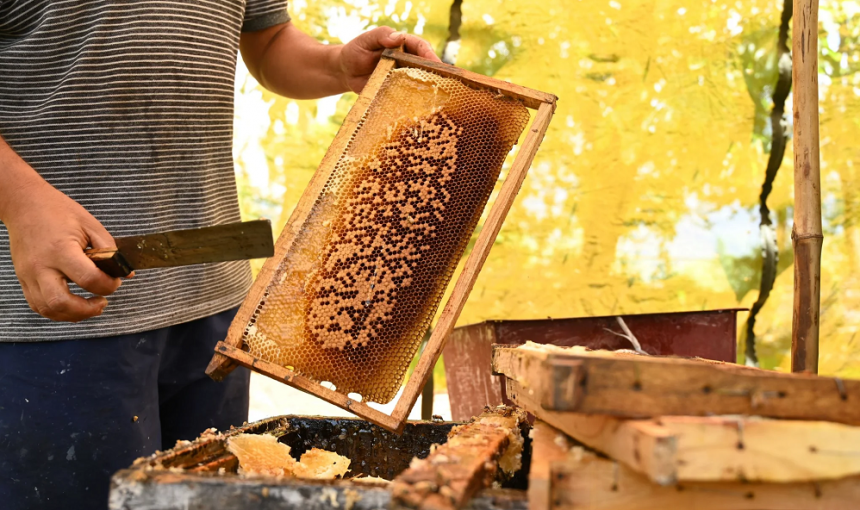LIQUID GOLD
Come autumn, the sweet elixir of Kashmir’s honey, referred to locally as Maach will be harvested in the Valley. Not just a tradition of flavors but a brand name with unique cultural significance in the region. An enduring legacy of our rich biodiversity, and a gem that nature bestows us during Harud, Maach simultaneously cues to harvest one’s own memories as well.
From ancient times, Kashmir is known as the land of honey (shehad) because some decades ago, there was hardly any house in villages without a traditional beehive. No doubt, bee-keeping (apiculture) has turned to an industry now, with big opportunity for the local youth to start a profitable venture using the new methodology as apiarists. Yet, nothing can vie with the charm of traditional wall-hives.
Sir Walter Lawrence has mentioned Maach in his book ‘The Valley of Kashmir’ that honey was cultivated in villages of the region and used for an item of taxation. The famous historian Kalhan (AD 1148-1150) in his book ‘Rajatarangini’ also states that honeybees existed in Kashmir from old times, living in natural abodes, and was a trade item with appreciated medicinal value.
As autumn sets in, the withered away flowers prick people to go for ‘Maach’ harvesting. As home remedy, it is revered for its healing properties, a natural therapy for ailments of the body and soul. It’s evidence to the valley’s ancient wisdom, a bridge between nature and human experience.
The Kashmiri variety is the best and purest honey, one can have to foster a healthy lifestyle. It is thick, gold hued sticky liquid with an exotic aroma that turns out to be everyone’s favorite. It crystallizes very slowly and has been, from ages, recognized as an Ayurvedic medicine to cure various diseases, having vitamins, minerals and antioxidants, essential for over all development of human body.
In the Holy Qur’an, ‘Maach’ is described as the best source of healing, and it is also listed as one of the foods of Jannah (paradise). The Prophet Muhammad (PBUH) once said: “By Him in whose hands is my soul; eat honey for there is no house in which honey is kept, and the angels will not ask for the mercy”. Maach heals wounds, cures long lasting cough, boosts immunity, cures depression, lowers bad cholesterol, etc. Succinctly, if a person eats honey, a thousand remedies enter his stomach, and a million diseases go out.
An emblem of Kashmir’s resilience, it’s a reminder of the valley’s ability to thrive in the face of hardships. Like the honey, people here have also learned to extract sweetness from the bitter experiences. As we savor the taste of Maach, we need to remind ourselves the beauty of nature, the link of all living things on earth, and the line, ‘An Poshi Teli, Yeli Wan Poshe’, said by Sheikh-ul-Alam (RA).
I can’t resist recalling how we followed the traditional system of bee-keeping of having a Maach Oal (wall-hive) on cowshed wall, near our house with a wooden box fitted inside. To collect honey in mid-autumn, my mother would first burn smoke under the hive to repel the bees for sometime. Protecting her face and hands with polythene, she would then extract honey combs locally known as Maach Kakar in a basket, to be later crushed and squeezed into honey.
A symbol of wisdom & community, Maach was kept for winter use and also distributed among neighbors. I still remember the day when we had extracted Maach and asked Masjid Imam on morning tea, called Gul Saeb by us, then. After tasting Maach with Makkai Tchout (maize flour bread), no sooner did he leave towards the beehive than he was pounced upon by the honeybees, as some honey had stuck to his beard.
Amidst new approach of honey harvesting, let us not forget to be in touch with our roots and rejoice the traditions that defined us. Through collective efforts, we can preserve it as cultural legacy for coming generations for which this humble write-up is an endeavor not to forget the traditional technique of collecting honey too.
(Author is a Columnist and can be reached at: [email protected])








